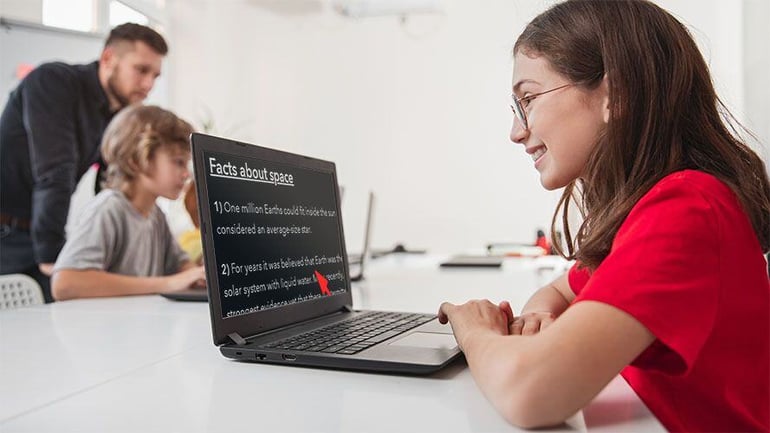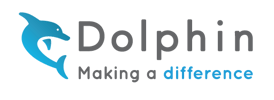Empowering Every Learner: How Dolphin Assistive Technology Helps Your Setting Meet Ofsted Inclusion Expectations
Creating an inclusive classroom won’t only benefit the pupils in your class with additional needs, it ensures every young person in your class is included and feels valued. Achieving inclusivity in schools - especially for learners with vision impairments and neurodiverse profiles such as dyslexia - demands more than empathy. It requires carefully-chosen tools, consistent support, staff training and leadership that recognises accessibility needs a whole-school approach for effective teaching and learning.
Assistive technology comes in many forms, but SuperNova Education Kit and EasyReader Education from Dolphin are specifically designed and developed to give young people with vision impairment, dyslexia and other SEND requirements the same chance to succeed as their classmates.
This technology doesn’t just improve students’ experience, it also saves your teaching team time: When your students can learn independently, your teachers and support staff spend less time removing barriers, and more time supporting young people with their learning. With the right technology, your school can meet more of the expectations set out in the Ofsted Education Inspection Framework (EIF)

Understanding the OFSTED EIF and Its Relevance to SEND and Inclusion
The Ofsted Education Inspection Framework (EIF) forms the basis for the ways Ofsted judges the effectiveness of schools in England. It’s structured around four key areas:
- Quality of Education
- Behaviour and Attitudes
- Personal Development
- Leadership and Management
For schools supporting pupils with Special Educational Needs and Disabilities (SEND) – which includes vision impairments and dyslexia - the framework demands high expectations, access to learning for all and a curriculum that’s inclusive by design.
The good news is that Dolphin education software supports these principles directly, and measurably.

-
Quality of Education: Delivering a Curriculum That Works for Everyone
One of the OFSTED Education Inspection Framework's strongest principles is that all pupils must be able to access a broad, balanced and ambitious curriculum. This doesn't mean you should simplify content, it indicates you should deliver it in ways that work for different learners.
The SuperNova Education Kit makes this possible. Its combination of SuperNova assistive technology software means students with vision impairments can:
- Magnify electronic documents on screen, read and write content, invert colours, and access information via speech or Braille as needed.
- View the contents of the classroom whiteboard on their device using SuperNova Connect and View, when their teacher shares it via the Dolphin Whiteboard Assistant. This enables real-time, accessible learning from shared classroom presentations, from any seat in class.
- Use the HoverCam included in the SuperNova Education Kit to read print worksheets or textbooks independently, this helps reducing reliance on adult support.
Meanwhile, EasyReader Education gives all students with print impairments – which includes dyslexia and vision impairments the means to read and succeed, with:
- Access to over a million accessible books, including textbooks and other learning material, through the partnership between EasyReader and RNIB Bookshare Education Collection. Please note: membership to this library is available free to all young people with a print impairment, not only those with vision loss.
- The ability to customise their reading experience using dyslexia-friendly fonts, adjusted spacing, enlarged text colour schemes and synchronised audio.
Using EasyReader Education promotes curriculum access without compromising content. It directly supports Ofsted’s expectations that learning must be sequenced, inclusive and ambitious for all.
-
Behaviour and Attitudes: Encouraging Confidence and Autonomy
The OFSTED EIF also considers how well pupils behave and engage with their education, including their levels of motivation and independence.
Dolphin assistive technology makes it possible for young people to access reading material and read it independently at school and at home. To this end, Dolphin tech helps:
- Build self-esteem and confidence - vital for pupils who may otherwise feel isolated or dependent on adults.
- Support consistent classroom routines – it removes logistical barriers such as requiring enlarged paper handouts or a human reader.
- Reinforce a culture of equity - where learners of all abilities can participate fully with their peers.
Whether it’s a pupil navigating a lesson confidently with SuperNova, or using EasyReader to read a class novel in ways which are accessible to them, both tools empower learners to take ownership of their progress, which is something Ofsted clearly values under this judgement.
- Personal Development: Preparing Pupils for Life Beyond School
Personal development within the OFSTED Education Inspection Framework refers to a broad set of outcomes, which include preparing pupils for adult life, building character and encouraging resilience and participation.
Dolphin assistive technology for education contributes to this in real ways:
- SuperNova teaches pupils independence, helping to build the vital assistive technology skills they are likely to use in further education and throughout their careers
- Young people using EasyReader Education are more likely to develop a love of stories and an enjoyment of reading for pleasure, it removes the barriers of decoding and visual fatigue.
- Both tools help pupils develop self-advocacy, this is a vital life skill, especially for those with Special Educational Needs and Disabilities (SEND).
Reading for pleasure is a clear benefit, as this is proven to have an impact on almost all areas of future success, but so is the social inclusion that comes when pupils can join in with lessons, discussions and school life without feeling ‘othered’ by their reading impairment.
-
Leadership and Management: Demonstrating a Strategic Approach to Inclusion
Perhaps most crucially for SEND teams, Special Educational Needs Coordinators (SENCOs) and senior leadership teams, the OFSTED EIF focuses heavily on the role of leadership in ensuring high-quality provision for all.
Dolphin technology supports leadership in several practical ways:
- Both SuperNova and EasyReader Education offer Continuing Professional Development (CPD) - accredited training, ensuring staff feel confident in their use. This is delivered online with courses that fit into busy educators’ schedules.
- EasyReader can integrate with systems like Google Classroom and Microsoft Education, to help streamline access to inclusive content across the school.
- These tools enable support even before a formal diagnosis is in place, which is essential in reducing delays and promoting early intervention.
When schools embed assistive technology into their wider SEND strategy, leaders can show a coordinated, proactive commitment to accessibility, which Ofsted will recognise as best practice.
Real Classroom Examples of Dolphin in Action
Want to see the theory in practice? Here are examples of how schools can use Dolphin assistive technology in schools:
- In a Key Stage 3 (KS3) maths class, a pupil with low vision uses SuperNova and can read the content the teacher has displayed on the classroom whiteboard at the same time as the rest of the class. As the teacher uses the Dolphin Whiteboard Assistant, they can share the presentation with the SuperNova user at the same time - directly to the student's laptop. The student can then zoom, freeze, and colour-adjust the view to suit their needs - with zero disruption to the rest of the class.
- During English lessons, a Year 6 pupil with dyslexia can listen to the audiobook version of the class text via EasyReader Education, following along with dyslexia-friendly large print on the iPad screen. They are able to comprehend the meaning of the story, as they can read faster, and think of questions ready for a group discussion.
- A vision impaired student completes an assignment using SuperNova Magnifier and Screen Reader. They are pleased not to stand out in class, as they no longer need reading material enlarged onto A3 paper, or a Teaching Assistant to read the text aloud.
- The school’s SENCO uses CPD training from Dolphin to build staff confidence and embed inclusive planning into their whole-school development plan.
- The classroom teacher experiences less low-level disruption in class, as all students can read the text in the way they find most comfortable, and they don’t need to wait for students to set up complicated equipment.
Six Steps to Implement Dolphin Technology Successfully
Is your setting ready to take the next step? Here’s a roadmap for effective classroom implementation:
- Assess pupil needs: Consult with Qualified Teachers of Vision Impairment (QTVIs) at your Local Education Authority, check Individual Education Plans (IEPs) and Education, Health and Care Plans (EHCPs), and involve pupils in decision-making.
- Install and equip: Provide your students with the SuperNova Education Kit (which includes everything you need for a vision impaired student), install the EasyReader Education software onto your classroom devices – you may need to speak to your IT team about this. Provide any additional equipment e.g. electronic Braille displays and link to your students’ RNIB Bookshare library membership.
- Provide training: Make the most of CPD-accredited sessions to train your teaching teams – inset days and training afternoons are perfect for this. Following training they will be certified to train the young people using the software to use their Education Kit or browse, download and read accessible versions of books with EasyReader Education.
- Integrate into everyday lessons: Use digital worksheets to share homework and handouts, provide reading lists via EasyReader, and allow SuperNova users to fully engage with whiteboard content and classroom activities.
- Review and reflect: Get feedback from learners, teaching team and their families to adapt your support.
- Embed in whole-school strategy: Showcase your inclusive practice in your School Improvement Plan and SEND Information Report.
The Takeaway: Inclusion Is a Whole-School Commitment
Dolphin SuperNova Education Kit and EasyReader Education aren't just tools for individual pupils, they act as vehicles for systemic inclusion. Their use sends a powerful message: "In this school, every learner matters and every learner is equipped to achieve".
If your school is looking to strengthen its inclusive approach, or simply preparing for an Ofsted inspection, these technologies offer both impact and evidence. You are welcome to call the Dolphin team directly for further information on 01905 754 577 or email info@yourdolphin.com to talk to an assistive technology advisor, and find the best fit for the students at your setting.






Let Us Know What You Thought about this Post.
Write your comment below.